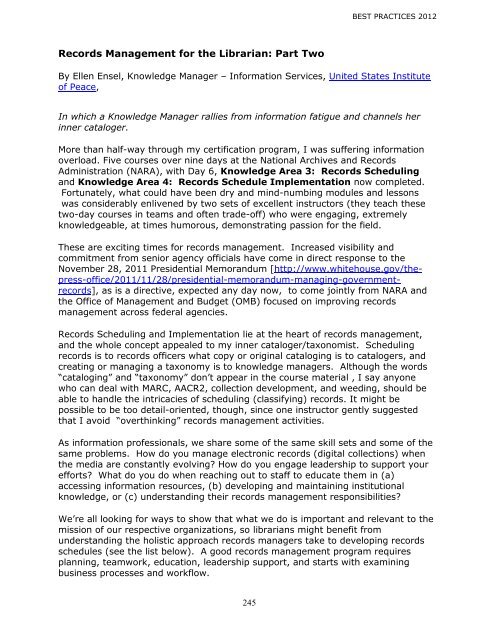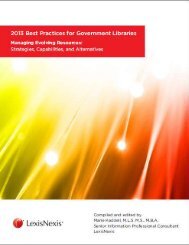2012 Best Practices for Government Libraries
2012 Best Practices for Government Libraries
2012 Best Practices for Government Libraries
You also want an ePaper? Increase the reach of your titles
YUMPU automatically turns print PDFs into web optimized ePapers that Google loves.
Records Management <strong>for</strong> the Librarian: Part Two<br />
245<br />
BEST PRACTICES <strong>2012</strong><br />
By Ellen Ensel, Knowledge Manager – In<strong>for</strong>mation Services, United States Institute<br />
of Peace,<br />
In which a Knowledge Manager rallies from in<strong>for</strong>mation fatigue and channels her<br />
inner cataloger.<br />
More than half-way through my certification program, I was suffering in<strong>for</strong>mation<br />
overload. Five courses over nine days at the National Archives and Records<br />
Administration (NARA), with Day 6, Knowledge Area 3: Records Scheduling<br />
and Knowledge Area 4: Records Schedule Implementation now completed.<br />
Fortunately, what could have been dry and mind-numbing modules and lessons<br />
was considerably enlivened by two sets of excellent instructors (they teach these<br />
two-day courses in teams and often trade-off) who were engaging, extremely<br />
knowledgeable, at times humorous, demonstrating passion <strong>for</strong> the field.<br />
These are exciting times <strong>for</strong> records management. Increased visibility and<br />
commitment from senior agency officials have come in direct response to the<br />
November 28, 2011 Presidential Memorandum [http://www.whitehouse.gov/thepress-office/2011/11/28/presidential-memorandum-managing-governmentrecords],<br />
as is a directive, expected any day now, to come jointly from NARA and<br />
the Office of Management and Budget (OMB) focused on improving records<br />
management across federal agencies.<br />
Records Scheduling and Implementation lie at the heart of records management,<br />
and the whole concept appealed to my inner cataloger/taxonomist. Scheduling<br />
records is to records officers what copy or original cataloging is to catalogers, and<br />
creating or managing a taxonomy is to knowledge managers. Although the words<br />
“cataloging” and “taxonomy” don’t appear in the course material , I say anyone<br />
who can deal with MARC, AACR2, collection development, and weeding, should be<br />
able to handle the intricacies of scheduling (classifying) records. It might be<br />
possible to be too detail-oriented, though, since one instructor gently suggested<br />
that I avoid “overthinking” records management activities.<br />
As in<strong>for</strong>mation professionals, we share some of the same skill sets and some of the<br />
same problems. How do you manage electronic records (digital collections) when<br />
the media are constantly evolving? How do you engage leadership to support your<br />
ef<strong>for</strong>ts? What do you do when reaching out to staff to educate them in (a)<br />
accessing in<strong>for</strong>mation resources, (b) developing and maintaining institutional<br />
knowledge, or (c) understanding their records management responsibilities?<br />
We’re all looking <strong>for</strong> ways to show that what we do is important and relevant to the<br />
mission of our respective organizations, so librarians might benefit from<br />
understanding the holistic approach records managers take to developing records<br />
schedules (see the list below). A good records management program requires<br />
planning, teamwork, education, leadership support, and starts with examining<br />
business processes and workflow.



